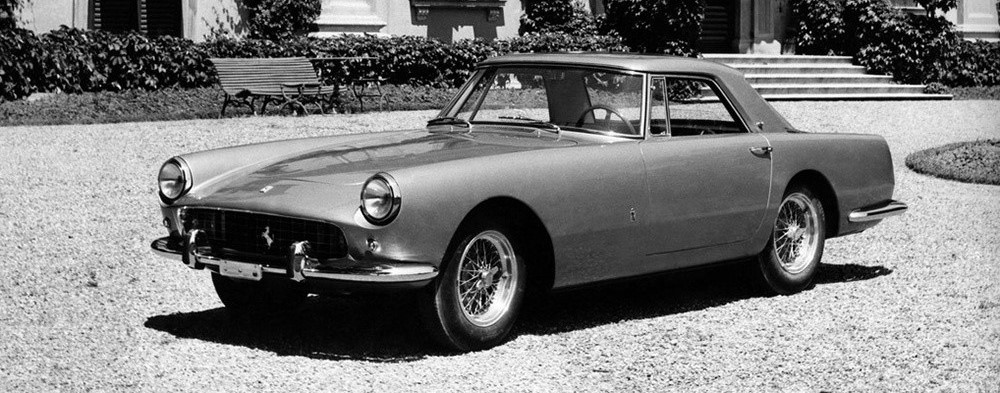
The 250 GT Coupé, was the immediate successor to the 250 Europa model, and was presented to the public at the 1954 Paris Salon, initially also being called the 250 Europa. However, the GT suffix to the model title was soon added, to help differentiate it from its predecessor, and then it became known simply as the 250 GT.
The overall shape of the majority of the series was virtually identical to that of the 250 Europa Pinin Farina three window coupe that preceded it, in fact unless you had a keen eye for dimensions, you would need a tape measure to tell them apart, the main difference being in the distance between the front wheel arch and the “A” post.
Full uniformity of line for complete series of a model was still to be achieved, as one example had special Vignale coachwork for Princess Liliane De Rethy in Belgium, and seven cars had varying designs of berlinetta bodies constructed in aluminium by Pinin Farina, that are often regarded as prototypes for the upcoming “Tour de France” berlinettas produced between 1956 and 1959. Also, even some of the “standard” coupes had some detail body modifications to suit a particular client’s requirements, whilst some were bodied in steel, and others in aluminium. As with the 250 Europa series, some examples had a rear “seat”, but in practise it was really an upholstered luggage platform.
The largest and most important differences between the 250 Europa and 250 GT Coupé lay under the bonnet. By exchanging the “long” block Lampredi engine of the former model for the Colombo “short” block V12 engine design, as used in the 250 MM etc, it enabled the wheelbase to be reduced by 200mm to 2600mm, without compromising cabin space, whilst concurrently the front and rear track were each increased by 29mm. The chassis’, with factory type reference 508, were numbered in the odd number road car sequence carrying a “GT” suffix, and comprised of two main longitudinal tubes, with cross bracing, and outriggers to support the body, with the main chassis tubes now passing above the rear axle, as opposed to under it on the 250 Europa/375 America series. The suspension was independent at the front, initially with twin wishbones, lever type hydraulic shock absorbers, and a transverse leaf spring, which was superseded by individual coil springs during the production run, whilst the rigid rear axle was supported on semi elliptic leaf springs, and fitted with lever type hydraulic shock absorbers. Hydraulically operated drum brakes were fitted all round, and the handbrake was cable operated on the rear wheels. Apart from one car, all examples were left hand drive.
As noted, the engine, although still a 3 litre V12 unit, was completely different from that in the 250 Europa, being a development of the Colombo designed “short” block V12 unit, with a capacity of 2953cc, and a bore and stroke of 73mm x 58.8mm, fitted with a bank of three twin choke Weber 36 or 42 DCZ carburettors, with twin coil and front horizontal mounted distributor ignition, to produce a claimed 220bhp. This was coupled to a four speed all synchromesh gearbox, driving through a propeller shaft to the rigid rear axle, for which a range of ratios were available. Perhaps an explanation of the “long” and “short” block descriptions would not go amiss at this juncture. The Lamrpredi “long” block design featured cylinder liners that screwed into the cylinder heads, which needed greater bore spacing than the Colombo “short” block design, which had more conventional push fit cylinder liners and a standard head gasket arrangement, which is more compact.
This model was an important landmark in the Ferrari production car story, as it had the largest relatively homogenous model production run up to that time, and it marked the point where Pinin Farina became, with only one subsequent exception, the sole designer of Ferrari series production cars to date. Also the engine/chassis combination would, with upgrading and modification, form the backbone of Ferrari production car output, in the form of the various 250 GT models, for a decade.
 Engine
Engine
- Type front, longitudinal 60° V12
- Bore/stroke 73 x 58.8 mm
- Unitary displacement 246.10 cc
- Total displacement 2953.21 cc
- Compression ratio 8.5 : 1
- Maximum power 162 kW (220 hp) at 7000 rpm
- Power per litre 74 hp/l
- Valve actuation single overhead camshaft per bank, two valves per cylinder
- Fuel feed three Weber 36 DCZ/3 carburettors
- Ignition single spark plug per cylinder, two coils
- Lubrication wet sump
- Clutch twin-plate
Chassis
- Frame tubular steel
- Front suspension independent, unequal-length wishbones, transverse leaf spring, hydraulic shock absorbers
- Rear suspension live axle, single radius arm, semi-elliptic springs, hydraulic shock absorbers
- Brakes drums
- Transmission 4-speed + reverse
- Steering worm and sector
- Fuel tank capacity 100 litres
- Front tyres 6.00 x 16
- Rear tyres 6.00 x 16
Bodywork
- Type coupé, two-seater
- Wheelbase 2600 mm
- Front track 1354 mm
- Rear track 1349 mm
- Weight 1050 kg (dry)
Performance
- Top speed 230 km/h


1956 Ferrari 250 GT Coupé was one of just five Ferrari 250 GT long-wheelbase chassis cars designed by Zagato. The V12-powered lightweight model has an elegant coach-built body with Zagato’s trademark double-bubble roof.


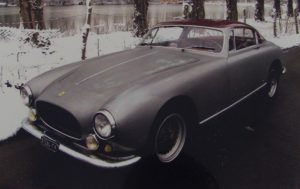
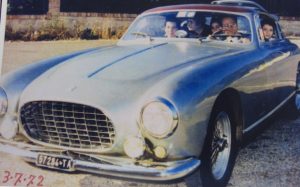


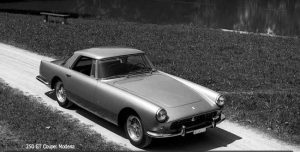
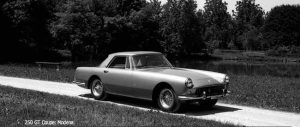


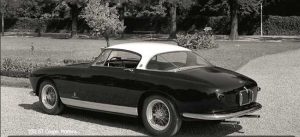

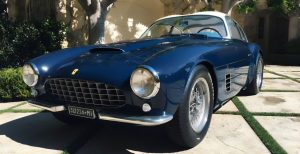
You must be logged in to post a comment.